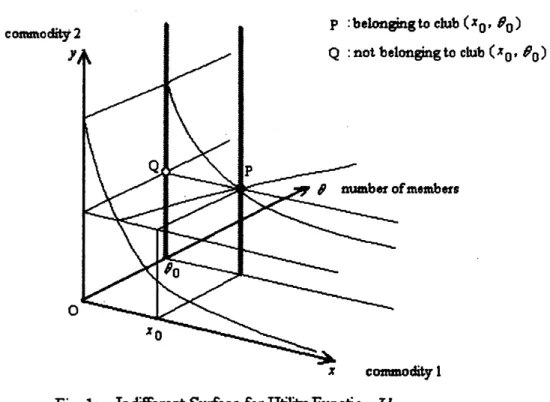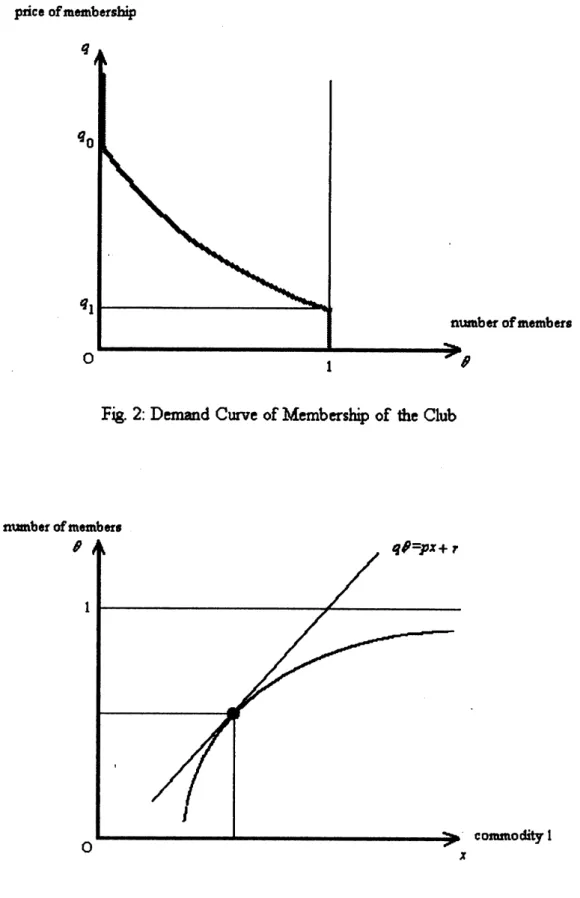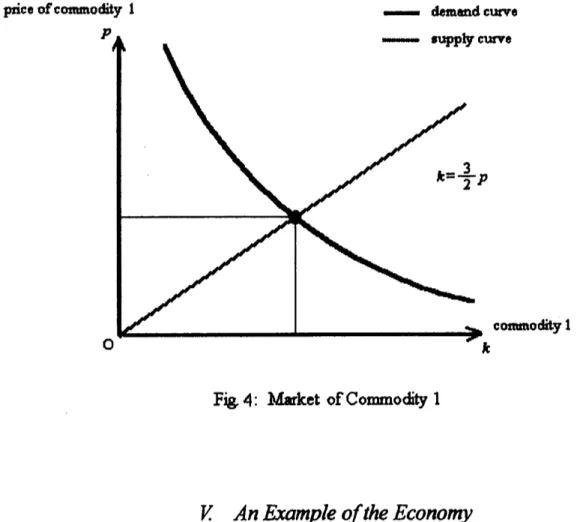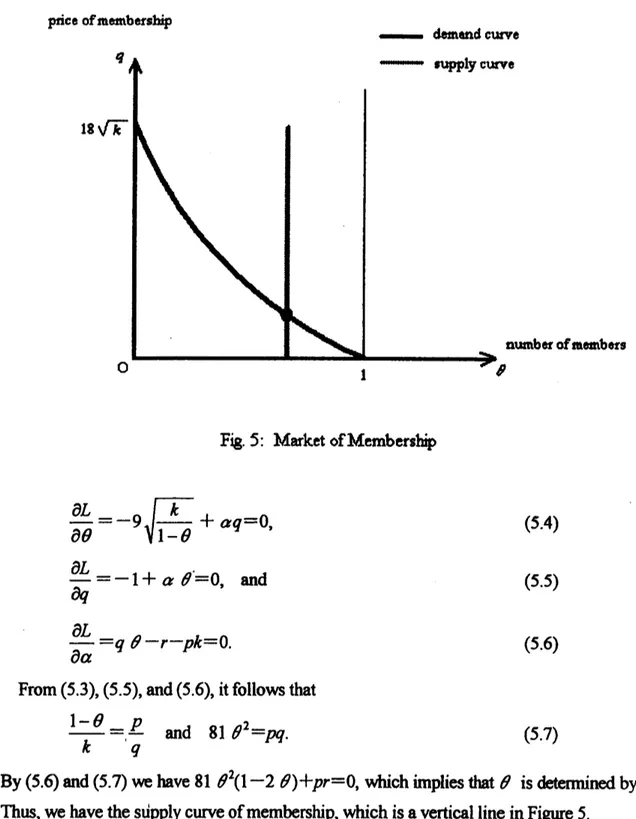The Competitive Equilibrium
and Pareto
Optimum
Allocations
in
the
Economy
with Clubs
Shin-Ichi Takekuma
GraduateSchoolofEconomics,
Hitotsubashi University
Abstract
Tk competitive equilibrium is defined for aneconomy with aclub and many identical consumers. In an
example ofthe economy,the eristence of the competitive equilibium is shown Also, it is proved that any
allocationunderthecompetitiveequilibriumintheeconomy isParetooptimum
I.
Introduction
Groups ofpeople who share and jointly
consume
goodsare
called “clubs”,or
consumptionownels呻membership alTangements. G\otimes 出consumed inclubs
are
intemediate $\mathrm{g}\infty \mathrm{d}\mathrm{s}$ 反oen
purelyprivategoodsand purelypublicgoods. Inthis
paper
we
shall considerasimple model ofaneconomy where there is
one
club and thereare
many, but identicalconsumers.
The market ofmembership ofthe dubisanalyzed and thecompetitiveequilibri umfor theeconomyis defined In
an
example ofthe economy, the competitive equilibrium is shown to exist. Our definition ofcompetitive
$\eta \mathrm{u}\mathrm{i}1\mathrm{i}\mathrm{b}\mathrm{r}^{\mathfrak{l}}\mathrm{i}\mathrm{u}\mathrm{m}$is
an
extension
of the usual competitive equilibrium foreconomies
onlywith private goods. In
addition,
allocations underthecompetitive
equilibriumare
proved to beParetooptimum.
In his famous
paper
J. $\mathrm{M}$ Buchanan (1965) presented amodel of economy with clubs, andconsidered Pareto optimality of allocations in the economy. Following his
paper,
many papershave beenpublished(fordetail,conferthesurvey article byT. Sandierand J. T. Tschirhart (1980)).
In most
papers
suchas
$\mathrm{Y}$-K. Ng (1976), 1974, 1978), E. Berglas(1976), and E. Helpmanand A.$\mathrm{L}\backslash$
.
数理解析研究所講究録 1215 巻 2001 年 64-77
Hillman (1977), the optimality of alocations
was
considered
In afewpapers,
the competitive equilibriumforeconomies
withclubsis
analyzed,
for example, byS. Scotchmer and$\mathrm{M}$H. Wooders(1987). Onthe other
1mA
acompetitive equilibriumwas
definedby D. Foley(1967) andD. $\mathrm{K}$Richter(1974) for
economies
withpublicgoods, whichis
aspecialcase
of clubs. However, suchan
equilibrium is quite different from the equilibrium ineconomies
with clubs, because clubsare
independent agents andbehave for their
own purpose.
The definition ofcompetitive equilibrium depends
on
the behavior of clubs. In thispaper
we
assume
that the club$\ovalbox{\tt\small REJECT}$ itsmembers’ utilities. Inour
modelofeconomyallindividualare
assumedtobe identical in thattheir utility$\mathrm{f}\mathrm{f}\mathrm{i}\mathrm{n}\alpha \mathrm{i}\mathrm{o}\mathrm{n}\mathrm{s}$
are
thesame
andtheyhave initiallythesame
amount of wealth By virture of this $\mathrm{a}\mathrm{s}\mathrm{s}\iota \mathrm{n}\mathrm{n}\mathrm{p}\mathrm{t}\mathrm{i}\mathrm{o}\mathrm{L}$
we
can
easiy define anatural concept ofcompetitiveequilibrium for theeconomy. However,ingeneral cases,
we
expedthatmany kindsofequilibriumconceptsmight bedefined
II. A
General Model
Firstwepresentageneral model ofaneconomy with clubs. There
are
$J$kinds ofcommodities,eachof whichisshared andconsumed inaclub. Thus,there
are
$n$clubs intheeconomyand eachone
themis indicatedbyan
$\mathrm{i}\mathrm{n}\mathrm{d}\mathrm{e}\mathrm{x}\dot{\Gamma}^{-1},\cdots$,$J$. Clubjis
group people who share$\mathrm{c}\mathrm{o}\mathrm{m}\mathrm{m}\mathrm{o}\mathrm{d}\mathrm{i}\mathrm{t}\mathrm{y}/$inconsumptioa Also,there
are
$n$kinds of othercommodities,whichare
usualprivategoods andconsumed separately by each single
person.
We
assume
that individualsare
“divisibl\"e, and the set of all thepersons
in the economy isdenotedby$A$, whichis aunitinterval, i.e.,$A=[0,1]$.
Let
us
denote the quantity of commodity$j$ consumed inclub$j$ by$x_{j}$. Also, letus
denote thefraction people belongingtodub by $\theta_{j}$,where$0\leqq\theta_{j}\leqq 1$. Whenthesetofthe members ofdub
$j$is measurable subset$M_{j}\mathrm{o}\mathrm{f}A$, $\theta_{j}=2$(A4)where$X$(A4)istheLebesgue
measure
ofset$M_{j}$. Thetotal number ofindiiduals in the economy is
fix4
and$\mathrm{f}\mathrm{i}\mathrm{a}\alpha \mathrm{i}\mathrm{o}\mathrm{n}$$\#\mathrm{y}$-denotesthe number of people
participatingin$\mathrm{c}\mathrm{l}\mathrm{u}\mathrm{b}/$.
We
assume
thatpeopledo notcareaboutwhoare
members of$\mathrm{c}\mathrm{l}\mathrm{u}\mathrm{b}/$,butonlyaboutthenumberofits members. Therefore,$\mathrm{c}\mathrm{l}\mathrm{u}\mathrm{b}/$is describedbypair$(x_{j}, \theta_{j})$.
The utilityffinction ofperson$a\in A$is denotedby
$u=U_{o}((x_{1}, \theta_{1}),\cdots$, $(x_{n}, \theta_{n}),y)$,
where $y\in K$ denotes the quantities of private goods. The variable$\theta_{j}$ofclub $(x_{j}, \theta_{j})$ indicates $\mathrm{a}$
.
degreeofcongestion.
To denotethe utility of
aperson
whois
notamemberofaclub,we
assume
that peoplecan
getnothing fiom belongingto clubs in whichnothing
is
consumed Namely, when$x_{J}=0$, people in$\mathrm{c}\mathrm{l}\mathrm{u}\mathrm{b}/$get
as
thesame
level ofutilityas
peopleoutof$\mathrm{c}\mathrm{l}\mathrm{u}\mathrm{b}/$getThe production setofthe commoditiesconsumedin clubs and the privategoodsis denoted by $Y$,
whichis asubsetofthenon-negative orthant of
a
$(J+n)$-dimensional Euclideanspace.
Whenwe
write$(x,y)\in Y$,ffiej-thcoordinate of vector$x\in R^{J}$denotes
an
amountof thecommodity consumedin$\mathrm{c}\mathrm{l}\mathrm{u}\mathrm{b}/$,whereasvector$y\in F$denotesamountsofprivategoods.
Ngby measurable$\mathrm{f}\mathrm{f}\mathrm{i}\mathrm{n}\mathrm{c}\dot{\mathrm{u}}\mathrm{o}\mathrm{n}$
$m$
:
$Aarrow R$,letus
denote theincome
eachindividual,whicharisesfiun production ofcommodities. The total of
incomes is
pqud to the valued of commoditiesproducedinthe
economy.
Whenproduction$(x,y)\in Y$is
chosen and the price$\mathrm{o}\mathrm{f}x$is
$p\in R^{J},\mathrm{a}\mathrm{n}\mathrm{d}$thepriceofyis$q\in P$ thetotalvalue produced$\mathrm{c}\mathrm{o}\mathrm{m}\mathrm{m}\mathrm{o}\mathrm{d}\mathrm{i}\dot{\mathrm{b}}\mathrm{e}\mathrm{s}$is
$px+\emptyset/\mathrm{a}\mathrm{n}\mathrm{d}$the followingmusthold.
$\int_{A}m(a)da$ $=px+\wp$
Finally,
we
assume
thatevery
individualis
initially amember of each club where nothing is consumedintheclub,thatis,$x_{j}4$and $\theta_{J}=1$ in$\mathrm{c}\mathrm{l}\mathrm{u}\mathrm{b}/$. Initially, each$\mathrm{c}\mathrm{l}\mathrm{u}\mathrm{b}/$is
specified by$(0, 1)$,and every individual hasthemembership of$\mathrm{c}\mathrm{l}\mathrm{u}\mathrm{b}/$
.
Whenan
individual wants toleave $\mathrm{c}\mathrm{l}\mathrm{u}\mathrm{b}/$, hesells his membership inthe marketand$\mathrm{c}\mathrm{l}\mathrm{u}\mathrm{b}/$buysit. Ifthe price membership ofclubj is
$r_{j}$,then
theinitial
income
ofindividual$a$is
$m(a)+ \sum_{J^{1}}^{n}.r_{J}$ .III.
A
Simple Model
Now,
we
shall confineourselves toan economy
in whichthereare
twokinds ofcommodities,say$” \mathrm{c}\mathrm{o}\mathrm{m}\mathrm{m}\mathrm{M}^{\cdot}\mathrm{q}$ $1$” and commodity 2”. commodity
1is
agood shared and consumed in aclub.Theclubis
ayoup
people who share commodity 1in consumption. Weass
ume
that thereisonlyone
club in theeconomy.
Commodity2is
aprivate goodand consumed by each singleperson.
Inwhatfollows,
we
assume
that commodity2is numeraireandits price is alwaysunity.We
assume
that individualsare
“divisible” and the set ofall the persons in the economy isdenoted by$A$, which is aunit interval, i.e., $A=[0,1]$. Also,
we
assume
that all individuals areidentical,and their utilityffinctions
are
thesame
and theirincomes are
equal.Let
us
denote the quantity ofcommodity 1consumedin the clubby$x$. Also, letus
denote the.fraction of people belongingtotheclubby$\theta$,
wtoeoe
$0\leqq\theta\leqq 1$. Whentheset ofthe membersofthe club is ameasurable subset$M\mathrm{o}\mathrm{f}A$, $\theta=2(\lambda 4)$ wlaeoe$\mathrm{Z}\{\mathrm{M}$)is theLebesgue
measure
ofsetA#The totalnumberofindividualsin the
economy is
fix4
andfiwrion d¬oethenumber ofpeopleparticipatingin the club.
We
assume
thatpeopledonotcare
about whoare
members oftheclub,butonlyabout the number ofitsmembers. Therefore,theclubis
describedbypair
$(x, \theta)$.The utilityfimction ofeach
person,
whobecomesamember club$(x, \theta)$,is
denotedby$u=U((x,\theta)$,$y)$,
where$y$denotesthequantityof commodity
2.
The variable dotclub $(x, \theta)$indicates degree ofcongestion. Thefollowingassumption
means
that people prefer aless crowdedclub.
Assumion 3.1: $U$is acontinuous ffindion and $U((x,\theta),y)$ is increasing inboth$x$and$y$, and
decreasingin
7.
On the otherhand,
we
denote theutilityofaperson
who isnotamember ofthe clubby$u=V(\gamma)$.
Assumption3.1: $V(yFU((0,\theta),y)$ for ally and
7.
The aboveassumption implies that people
can
get nothing ffom belonging to the club in whichnothingis consumed. Namely, when $=0$,people in club$(x, \theta)$ get
as
thesame
level of utilityas
people outoftheclubget.
In Figure 1,
an
indifference sufface for the utility $\mathrm{f}\mathrm{i}\mathrm{m}\alpha \mathrm{i}\mathrm{o}\mathrm{n}$satisfying the above assumptionsis
illustrated
Theproductionset ofcommodities 1and2isdenoted by $Y$, whichisasubset ofthenon-negative
orthant ofa2-dimeniionalEuclideanspace.
Assumption3.3: Set$Y$isnon-empty, closed,and
convex.
Next, let
us
denote by $m$ the income of each individual, which arises ffom production ofcommodities. The total ofincomesisequal to the valued commoditiesproducedintheeconomy.
Whenproduction$(x,y)\in \mathrm{Y}$ischosen andtheprice ofcommodity 1is$p$,thetotal valueofproduced.
Fig. 1: IndifferentSu&ce for UtilityFunction $U$
commodities
is
$px+y$,andthe following musthold.$m= \int_{A}mda=px+y$
Namely, thevalue of produced commodities
is
diMbutd equallyamong
allthe individuals in theeconomy.
Finally,
we assume
thatevery
individualisinitiallyamember oftheclubandnothingiscons
umedintheclub,thatis,$x4$and $\theta=1$ inclub$(x, \theta)$. Initially, theclubisspecified by$(0, 1)$,andevery
individual has the membership ofclub$(0, 1)$. When
an
individualwantsto leave theclub, he sellshis membership in themarketand the clubbuys
it.
Iftheprice of membership of club$(0, 1)$ is$r$,thenthe initialincome ofeach individual is$m+r$
.
IV
Competitive
Equilibrium
As
some
individuals leave the cluband the club buyssome
amountof commodity 1club$(0, 1)$changes toclub $(x, \theta)$. Let
us
denote the price ofmembership ofclub $(x, \theta)$ by$q$. Price$q$ is anadmission fee that individuals have to
pay
if they join club $(x, \theta)$. Since each individual isnegligible, and single
person
doesnotaffect variable Iofclub$(x, \theta)$.The budget
consffaint
whicheachindividualmust satisfyinjoiningtheclub,isdenoted by$q+y\leqq m+r$,
where$y\mathrm{i}\mathrm{s}$theamountofconsumption commodity
2.
Thus,eachperson
willcontinue tojoin
theclub if$V(m+r)<U((x,\theta),m+r-q)$,
or
leavethe club if$V(m+r)>U((x,\theta),m+r-q)$.
Given$m$,$r$,andx,let
us
define$q_{0}$and$q_{1}$by$q_{0}= \max\{q|V(m+r)\leqq U((x,0),m+r-q)\}$
and
$q_{1}= \max\{q|V(m\dagger r)\leqq U((x,1),m+r-q)\}$.
ByAssumption3.1,
we
have$q_{0}\geqq q_{1}$. When$q>q_{0}$,nobodywill join theclub,andtherefore $\theta=$ $0$. Ontheotherhand,when$q\leqq q_{1}$,everybody willjoin theclub,andtherefore $\theta=1$. When$q_{0}\geqq$$q>q_{1}$,
some
will jointheclub,butothers willnot The fiaction$\theta \mathrm{o}\mathrm{f}$individualsjoining the dubisdetermined by
$V(m+r)=U((x,\theta),m+r-q)$,
and$0\leqq\theta<1$. We write the above relation
as
$\theta=\mathrm{X}q,x$,$m$,$r$).Thus,thedemand formembershipoftheclub isdefined by
$\theta$$=F(q,x, m, r)\equiv\{$
1 $0\leqq q<q_{1}$
$f(q,x,m, r)$ $q_{1}\leqq q<q_{0}$ .
0 $q_{0}\leqq q$
Thedemand
curve
ofF has negativeslope withrespectto$q$as
depictedinFigure2.Now,
we
assume
that thepurpose
ofthe clubisto$\ovalbox{\tt\small REJECT}$itsmembers’ utilities. Inour
simplemodel economy, sinceindividuals
are
allidentical,we can
assume
that the club chooses$X$, $\theta$,and$q$
so as
to $\ovalbox{\tt\small REJECT}$ $U((x,\theta),m$\dagger$r-q$).
In $\mathrm{a}\mathrm{d}\mathrm{d}\mathrm{i}\dot{\mathrm{u}}04$ there is abudget constraint forthe club.Let$p$be thepriceof commodity 1. Then,the budgetconstraintfor the clubis
$\sqrt x+r=q\theta$.
The behavior of the club
can
be interpretedas
follows. Thereis amanager in theclub, whosejob is to $\ovalbox{\tt\small REJECT}$ the utilities of people joining the club. For that purpose, the manager will
determineamount$X$of commodity 1consumed intheclub, number$\theta$ of members oftheclub, and
price$q$ ofmembership. Thus,given$p$, $m$,and$r$,theclub will$\ovalbox{\tt\small REJECT}$ $U((x,\theta),m+r-q)$ with
respect to$X$,$q$,and $\theta$ under budgetconstraint$px\dagger r=q\theta$. Therefore,thedemand for commodity
1and thesupply membershipby theclub
are
definedby$G(p, m, r)\equiv\{(x, \theta, q)|px+r=q\theta$ and $U((x,\theta),m+r-q)\geqq U((z,n),m+r-s)$
for all$(\underline{7}, n,s)$with$p^{\underline{7}}+r=sn$
}.
price$\mathrm{o}\mathrm{f}\mathrm{m}\mathrm{e}\mathrm{r}\iota \mathrm{b}\mathrm{e}\mathrm{r}\mathrm{s}\mathrm{h}\mathrm{i}\mathrm{p}$
Fig.
2:
Demand Curve ofMembership of the Clubnumbe ofmembers
$\mathrm{c}$ommodity 1
Fig. 3: Behavior ofthe Club
Given$q$,asituation oftheclubis$\mathrm{i}\mathrm{u}\ovalbox{\tt\small REJECT}$inFigure
3.
Usually, thedemand forcommodity1 bytheclub will be adecreasing$\mathrm{f}\mathrm{i}\mathrm{u}\kappa\dot{\mathrm{h}}\mathrm{o}\mathrm{n}$$\mathrm{o}\mathrm{f}p$and thesuPply membershipbythe club will be
an
increasing function$\mathrm{o}\mathrm{f}q$.
Finally, producers$\mathrm{m}\ovalbox{\tt\small REJECT}$ thevalue ofcommodities, andthesupply functionofcommodity 1
and commodity2isdefined by
$H(p)\equiv$
{
$(\mathrm{x},\mathrm{y})$ $|px+y\geqq px’+y$’forall$(x’,y’)\in Y$}.
Inequilibrium, the following musthold:
$\theta=F(q,x, m, r)$, $(x, \theta, q)\in\infty$,$m$,$r)$, $(x,y)\in H(p)$, and $m=px+y$.
Thus, the competitive equilibrium for the economy
can
be described by ($\mathrm{p},$ $q,$ $(x, \theta),y,$$m,$ $r\}$ anddefined
as
follows:Definition 4.1: $\{p, q, (x, \theta), y, m, r\}$ is said to be
a
$\underline{\infty \mathrm{m}\mathrm{o}\mathrm{e}\dot{\mathrm{b}}\dot{\mathrm{h}}\mathrm{v}\mathrm{e}}$ equilibrium if the followingconditions
are
satisfied:(1) If $\theta$ $>0$, then $V(m+r)\leqq U((x,\theta),m+r-q)$ , and if $\theta<1$, then
$V\{m+r)\geqq$
$U((x,\theta),m+r-q)$.
(2) $px\dagger r=q\theta$ and $U((x,\theta),m+r-q)\geqq U((z,n),m+r-s)$ for all$(z, n,s)$will
$\sqrt{}^{\underline{7}}+r\leqq sn$.
(3) $(x,y)\in Y\mathrm{a}\mathrm{n}\mathrm{d}$$m=px+y\geqq\sqrt x’+y$’for all$(x’ y’)\in Y$.
Intheabove
definition,
condition(1)means
that eachperson
is$\ovalbox{\tt\small REJECT} \mathrm{g}$utility under abudgetconstlaiffi Condition(3)
means
that producersofcommoditiesare
$\mathrm{m}\ovalbox{\tt\small REJECT} \mathrm{g}$profits. Conditions(1)and(2)imply that themarket ofmembership is in equilibrium. Also, conditions (2) and (3) imply that the market of
commodity 1is in equilibrium. Therefore, by Walras’ law, the market of commodity 2is in
equilibrium.
The competitive $\mathrm{e}^{1}\mathrm{q}$uilibrium
can
be defined inmore
generalcases
(see Takekuma (1999)). Incondition(1) oflhe above$\mathrm{d}\mathrm{e}\mathrm{f}\mathrm{i}\dot{\mathrm{m}}\dot{\mathfrak{n}}\mathrm{o}\mathrm{l}$ each
person
simplydecides whetherhe(orshe)should theexisting club,
or
not Therefore,our
definition of competitive equilibrium is weaker than,or
different from thatofS. Scotchmer, S. andM. H. Wooders(1987),in which people choose
one
clubjoinamong manypotentiallyexisting clubs
priceofconu[off.iy $1$
– dunuldclub,
Fig.
4:
Market ofCommodity 1V. An EXample
ofthe
Economy
Inthis
section
we are
goingto showan
exampleoftheeconomy in Section I. Commodity 1,which
is
consumed in theclub,is
interpretedas
thefidities oftheclub.
Commodity 2,which is a privategood,is assumedto$\mathrm{k}" \mathrm{m}\mathrm{o}\mathrm{n}\mathrm{e}\mathrm{y}"$.
The set of all the
persons
in
theeconomy is
denoted by$A=[0,1]$. Letus
denote the size offacilities oftheclubby $k$andthefiaction ofpeople belonging to theclub by$\theta$, where$0\leqq\theta$$\leqq 1$.
Therefore,the club is characterizedbyapair$(k, \theta)$.
All individuals
are
identical, andtheirutility functions and the initial holdings of moneyare
thesame.
The utilty $\mathrm{f}\mathrm{f}\mathrm{i}^{1}\mathrm{n}$$\mathrm{c}\dot{0}\mathrm{o}\mathrm{n}$of eachperson,
when he(or she)is
amemberof club$(k, \theta)$,isassumedto have the followingspecial form.
$u=18\sqrt{k(1-\theta)}+y$,
where$y$ denotes the quantity ofmoney. On ffi other hand, the utility ofaperson who is not a
memberofthe club
is
assumedtobe$u=y$.
The cost for producing the $\mathrm{f}\mathrm{f}\mathrm{i}\mathrm{c}\mathrm{i}\mathrm{l}\mathrm{i}\dot{\mathrm{b}}\mathrm{o}\mathrm{e}$ of the club is denoted by acost $\mathrm{f}\mathrm{i}\mathrm{m}\mathrm{c}\dot{\mathrm{h}}\mathrm{o}\mathrm{L}$ which has the
followingspecial form.
$c= \frac{1}{3}\emptyset$.
Let$p\mathrm{b}\mathrm{e}$the
price
ofcommodityl. Producers commodity1maximize
profits,$\pi=pk-c=pk^{-}\frac{1}{3}t$.
Thecondition for profit
maximization is
$\frac{d\pi}{dk}=p-\frac{2}{3}k=0$, i.e., $k= \frac{3}{2}$
p.
(5.1)Therefore, the supply
curve
ofcommodity1is
astraightline withapositive
slope illustratedin
Figure4.
Each individual $\mathrm{i}\dot{\mathrm{m}}\dot{\mathrm{b}}\mathrm{a}\mathrm{u}\mathrm{y}$ holds the
same
amount $\overline{y}$ ofmoney, andwe
assume
that $\overline{y}=10$.Theprofitsobtained inproduction of commodity 1are$\eta \mathrm{u}\mathrm{a}\mathrm{U}\mathrm{y}$distributedtoalltheindividuals inthe
economy. Each individual receives the
same
amount $\pi$ profits from producers. In$\mathrm{a}\mathrm{d}\mathrm{d}\mathrm{i}\dot{\mathrm{u}}\mathrm{o}\mathrm{l}$every individual is$\mathrm{i}\cdot \mathrm{i}\dot{\mathrm{b}}\mathrm{a}\mathrm{u}\mathrm{y}$ memberofthedub where nothingisconsumed Let$r$be theprice of
membership of club $(0, 1)$. The total income of each indvidual is $\overline{y}$\dagger $\pi+r$, and the budget
constraint,which each individualmust satisfyinjoiningtheclub,is denoted by
$q+y\leqq\overline{y}$ $+$ $\pi+r$,
where$y$isthe amount ofmoneyand$q$istheprice of membershipofclub$(k, \theta)$. Therefore, each
personwill join theclub if $\overline{y}+\pi+r<18\sqrt{k(1-\theta)}$ \dagger$\overline{y}+\pi+r-q$,
or
will join the club if$\overline{y}+\pi\dagger r>18\sqrt{k(1-\theta)}$\dagger$\overline{y}+\pi+r-q$. Hence, the $\mathrm{f}\mathrm{i}\mathrm{a}\alpha \mathrm{i}\mathrm{o}\mathrm{n}\theta \mathrm{o}\mathrm{f}$individualsjoiningthe club
isdetermined by
$\overline{y}+\pi+r=18\sqrt{k(1-\theta)}+\overline{y}+\pi+r-q$, i.e., $q=18\sqrt{k(1-\theta)}$, (5.2)
ffom which the demand
curve
ofmembershipinFigure5isderived.The
purpose
of the club isto maximize its members’ utility. In club $(k, \theta)$, members’ utility.$18\sqrt{k(1-\theta)}+\overline{y}+\pi+r^{-}q$,ismaximized with respect to$k$, $\theta$,and
$q$under budgetconstraint$pk$
$+r=q\theta$. The Lagrangian for themaximizationproblemisdefined by
$L=18\sqrt{k(1-\theta)}+\overline{y}+\pi+r^{-}q+a(q\theta-r-\sqrt k)$,
where 4is Lagrangian multiplier. Thenecessaryconditions formaximization
are
$\frac{\partial L}{\partial k}=9\sqrt{\frac{1-\theta}{k}}-ap=0$, (5.3)
price$\mathrm{o}\mathrm{f}\mathrm{n}\mathrm{m}\mathrm{b}\mathrm{e}\mathrm{r}\mathrm{s}\mathrm{h}\dot{\varphi}$
–dmondcurve
Fig.5: Market$\mathrm{o}\mathrm{f}\mathrm{M}\mathrm{e}\mathrm{m}\mathrm{b}\mathrm{e}\mathrm{r}\mathrm{s}\psi$
.
$\frac{\partial L}{\partial\theta}=-9\sqrt{\frac{k}{1-\theta}}+aq=0$, (5.4)
$\frac{\partial L}{\Psi}=-1\dagger$
a
$d.=0$, and (5.5)$\frac{\partial L}{\partial a}=q\theta-r^{-}pk=0$
.
(5.6)From(5.3), (5.5),and(5.6), it follows that
$\frac{1-\theta}{k}=_{\mathrm{t}}\frac{p}{q}$ and
81
$\theta^{2}=m$. (5.7)By(5.6)and(5.7)
we
have81
$\theta^{2}(1-2\theta)+pr=0$, whichimplies that$\theta$is
determinedby$p$ and$r$.
Thus,
we
have thestipplycurve
membership,whichis
vertical lineinFigure5.Inequilibrium, by solvingsix equations ffom(5.1)to(5.6),
we
have $\theta=\frac{2}{3}$,$k=3,p=2$,$q=18$,$r=6$,and $a= \frac{3}{2}$. Furthermore, $\pi^{=}3$, andthe consumption ofcommodity 2by each member
oftheclubis $\overline{y}+_{X}+r^{-}q=1$,whereas theconsumption ofcommodity2byeachnon-memberis
$\overline{y}$ \dagger $\pi+r=19$
.
Thus, acompetitive equilibrium is shown to exist for this example of theMoreover,by(5.7)
we
have81 $\theta^{2}(1-\theta)=pk$which implies that$81 \theta(2-3\theta)\frac{\partial\theta}{\partial p}=k+p\frac{\partial k}{\Phi}$
.
Therefore,since$\theta=\frac{2}{3}$
.
equilibrium, $\frac{\partial k}{\Phi}=-\frac{k}{p}<0$holds inaneighborhoodoftheequilibrium.Namely,
we
have thedemandcurve
of commodity 1, which hasa
$\mathrm{n}\mathrm{e}\dot{\mathrm{g}}\mathrm{v}\mathrm{e}$ slope at the$\eta \mathrm{u}\mathrm{i}\mathrm{h}\mathrm{b}\mathrm{i}\mathrm{m}\mathrm{l}$illustrated inFigure4.
VI. Pareto
Optimum
ffocations
To describe
an
allocation in the economy,we
have to specify the amount ofcommodity 1consumed in the club, its members, and the $\mathrm{d}\mathrm{i}\mathfrak{W}\mathrm{l}\mathrm{b}\mathrm{m}\mathrm{i}\mathrm{o}\mathrm{n}$ofcommodity 2amongpeople. Let
us
denote the amount ofcommodity 1consumed inffie club by$X$ and the set of
its
members bya
measurable subset$M\mathrm{o}\mathrm{f}A$. Then,theclubis denotedby($x$,A#).
To denote thedistribution of commodity 2among individuals,
we use
areal-valuedmeasurablefimction$f$
on
$A$, where$\mathrm{f}\mathrm{i}\mathrm{a}$) is the quantity ofcommodity 2allocated to
person
$a\in A$. Thus,an
allocation in theeconomy is indicated by these threeelements, $\{(x, M),f\}$. An allocation $\{(x, M)$,
$]$ in theeconomy issaidtobe$\underline{\mathrm{f}\mathrm{e}\mathrm{a}\mathrm{s}\mathrm{i}\mathrm{b}\mathrm{l}\mathrm{e}}$if $(x, \int_{A}fda)\in Y$.
Inallocation $\{(x,\emptyset,J\}$,theutility ofmember\^a Mis $U((x, \lambda(M)),f(a))$,whereasthe utility
non-member$a\in A\backslash M\mathrm{i}\mathrm{s}V((a))$.
Definition 6.1: Afeasible allocation
{
$(x$, A4,$f$}
is said to be Pareto $\mathrm{o}\mathrm{D}\dot{\mathfrak{g}}\mathrm{m}\iota \mathrm{m}$ ifthere isno
otherfeasible allocation $\{(z,N),\mathrm{g}\}$ such that
(1) $U((x, \lambda(M)),f(a))\leqq U((z, \lambda(N)),\mathrm{g}(a))$ for all\^a $\mathrm{M}\mathrm{O}\mathrm{N}$, (2) $U((x, \lambda(M)),f(a))\leqq V(g(a))$ for all$a\in M\cap(A\psi$,
(3) $\nabla(Ka))\leqq U((z, \lambda(N)),\mathrm{g}(a))$ for all$a\in(A\backslash w\cap N$,
(4) $V(Ka))\leqq V(g(a))$ for all$a\in A\backslash (M\cup N)$,
andstrictinequalities hold for
some
a&A (withpositivemeasure).Now
we can
provethe basic theorem of welfareeconomicsforeconomieswithclubsTheorem
6.1:
Anyallocation inthecompetitiveequilibriumisParetooptimum.Proof Let$\{p, q, (x, \theta),y, m,r\}$be competitive equilibrium. DefineasetMand
a
$\mathrm{f}\mathrm{u}\mathrm{n}\mathrm{c}\mathrm{t}\mathrm{i}\mathrm{o}\mathrm{n}/\mathrm{b}\mathrm{y}$$M=[0, \theta]$ and $f(a)=\{$$m+r-q$ for$a\in M$
$m+r$ for$a\in A\backslash M$
By(2)and(3)$\mathrm{o}\mathrm{f}\mathrm{D}\mathrm{e}\mathrm{f}\mathrm{i}\mathrm{n}\cdot \mathrm{t}\mathrm{i}\mathrm{o}\mathrm{n}$$4.1$,
$\int_{A}fda=\theta(m+r^{-}q)+(1-d)$$(m+r)=m+r-dq=px+y+r-dq=y$,
andtherefore,$(x, \int_{A}fda)\in Y$
.
Namely, allocation{
$(x,M),fl$is
feasible.Now,
suppose
that alocation{(
$x$, A#),7}
were
not Pareto optimum. Then, byDefinition 6.1,thereis afeasible allocation $\{(z,N),\mathrm{g}\}$ suchthat
$U((x, \theta),m+r-q)\leqq U((z, \lambda(N)),\mathrm{g}(a))$ for all$a\in M\cap N$, (6.1)
$U((x, \theta),m+r-q)\leqq V(\mathrm{g}(a))$ forall$a\in M\cap(A\backslash N)$, (6.2) $V(m+r)\leqq U((z, \lambda(N)),\mathrm{g}(a))$ for all$a\in(AW)\cap N$, (6.3)
$V(m+r)\leqq V(\mathrm{g}(a))$ for all$a\in A\backslash (M\cup N)$, (6.4)
andskid inequalities hold for
some
a&A
with positivemeasure.
By(1) Definition4.1, $U((x, \theta),m+r-q)\leqq V(m+r)$holds in (6.3). TlrlefoIe, from (6.1)
and(6.3),it follows that
$U((x, \theta),m+r-q)\leqq U((z, \lambda(N)),\mathrm{g}(a))$ forall$a\in N$,
whichimplies, by(2)$\mathrm{o}\mathrm{f}\mathrm{o}\mathrm{e}\mathrm{f}\mathrm{f}\mathrm{i}\mathrm{i}\dot{\mathrm{u}}\mathrm{o}\mathrm{n}4.1$,that
$\mu\dagger r\geqq(m+r^{-}\mathrm{g}(a))A(N)$ forall$a\in N$
.
(6.3)By(1) Definition4.1, $V(m+r)\leqq U((x, \theta),m+r-q)$ holds in(6.2). Therefore, ffom (6.2), it
follows that $V(m+r)\leqq V\ovalbox{\tt\small REJECT} a))$forall$a\in M\cap(A\backslash N)$,whichimplies, byAssumption2.2,that
$m+r\leqq \mathrm{g}(a)$ for$\mathrm{a}11a\in M\cap(A\mathrm{W})$
.
(6.6)Moreover,(6.4)and
Assumption 2.2
imply that$m+r\leqq \mathrm{g}(a)$ forall$a\in A\backslash (M\cup N)$
.
(6.7)Since strictinequalities hold for
some
\^a $A$in(6.5),or
(6.6),or
(6.7),we
have,by integration,$m<pz+ \int_{A}\mathrm{g}da$,
which contradicts(3)ofOefinition
4.1.
$\blacksquare$References
Berglas,E.(1976),On thetheoryofclubs,AmericanEconomicReview66,
pp. 116-121.
Buchanan,J.$\mathrm{M}(1965)$ An
economic
theory clubs,Economica 32,pp.
1-14.Foley,D.(1967),Resourceallocation and the publicsector,YaleEconomicEssays 7,
pp.43-98.
Helpman,E. and A.Hillman(1977),Two remarks
on
optimal clubsize,Economica 44,pp.293-96.Ng, $\mathrm{Y}$-K.(1973), The
economic
theory of clubs: Pareto optimality conditions, Economica 40,pp.291-298.
.(1974),The
economic
theoryofclubs: Optimal$\mathrm{b}\mathrm{x}/\mathrm{s}\mathrm{u}\mathrm{b}\mathrm{s}\mathrm{i}\mathrm{d}\mathrm{y}$,Economica41,pp.308-321.
.(1978),Optimalclubsize:Areply, Economica 45,pp.407A10.
Richter, D. K.(1974), The
core
of apublic goods economy, International Economic Review 15,pp.131-142.
Smuelsok
P. A.(1954),Thepure
theoryof publicexpenditure, ReviewofEconomics
and$\theta atistics$36,
pp.387-89.
Sandier,T. and J. T.Tschiihart(1980),The
economic
theoryofclubs: Anevaluative survey, JournalEconomic Literature 18,pp. 1481-1521.
Scotchmer, S. and M H. Wooders(1987), Competitiveequilibrium and the
core
inclubeconomies
with
anonymous
crowding,JournalofPubtic
Economics 34, PP.159-173.Takekuma, S. (1999),Paretooptimum allocations inthe economywithclubs,Hitotsubashi Journal
Economics 40,pp.29A0.



